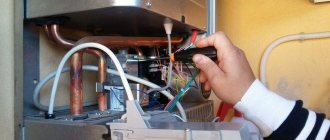What is included in the list of gas equipment?
According to the law, all gas equipment in apartments, apartment buildings and private houses requires periodic inspection and maintenance. It includes:
- General house equipment (risers to meters and taps inside residential premises).
- Indoor equipment. This includes any devices installed directly in the apartment.
Before the adoption of Resolution No. 410, management companies were responsible for all this management. The managers concluded contracts with gas workers themselves; the owners did not take part in this process. Payments for the services of service organizations were automatically distributed among tenants and included in payment receipts.
What is VDGO
VDGO stands for in-house gas equipment. These are pipes that go from the source of supply of a natural resource to a shut-off device, which is located at the branch of the gas supply to the gas equipment inside the residential premises.
There is another abbreviation - VKGO. We can say that these abbreviations mean almost the same thing and the decoding is consonant, but there is a difference between the concepts. VKGO is indoor gas equipment. It consists of pipes that go from the shut-off device to the gas appliances in the living room.
There is a whole network of gas pipelines that extends far beyond the residential premises of users. To ensure that consumers receive gas, storage facilities for this resource, distribution stations have been created, and a pipeline has been laid. In-house equipment is a gas pipe that is located inside the living space.
There are two types of this equipment:
- Common use. Such equipment includes pipe risers and locking devices, which are located both in the general area and directly in the residential premises.
- Private. This includes the gas pipes located in the apartment, as well as the gas equipment that is connected to them - these are stoves, speakers and other similar appliances.
Since 2003, in accordance with the Rules of Gas Distribution and Gas Consumption, Rostechnadzor has ceased to provide maintenance of gas equipment. Gasification did not stop, but there was no one to monitor the condition of the equipment. This led to a constant leakage of natural resources and explosions in residential buildings. For this reason, the Government of the Russian Federation has placed responsibility for the maintenance of gas equipment in apartments and common areas of multi-storey buildings on consumers of household gas. According to Decree of the Government of Russia No. 549 and Order of the Ministry of Regional Development No. 239, each owner of an apartment and private house is required to enter into an agreement on the maintenance of VDGO with a specialized housing and communal services organization. This should prevent gas explosions due to leakage of this natural resource. The housing and communal services organization is obliged to carry out technical maintenance of VDGO and VKGO in accordance with the contract, as well as current legislative acts.
On this basis, the rent includes not only gas supply, but also VDGO maintenance.
Main types of bubble levels
For a full cycle of construction work, it is necessary to use bubble levels of various lengths and configurations. The length of professional class meters is from 40 cm to 4 m. The same parameters for household models are 20-40 s.
Specialized models of bubble levels are equipped with two horizontal and one vertical capsules that allow you to measure angular deviations. The case with a loop design, depending on the surface, is secured using magnets or fixing tapes.
Professionals, as a rule, prefer to use bubble levels with a reinforced profile, which eliminates deformation when dropped and facilitates easy fitting. Such models also provide shockproof protection for transparent capsules with indicators.
The weight of the device is another important parameter, determined by the body material (wood, plastic, aluminum) and design solutions. The choice depends on the conditions of use: light models are the most universal, heavy models are intended for horizontal surfaces.
The ruler on the bar and the fluorescent liquid indicator provide additional ease of use.
Bilateral calibration of the body significantly expands the possibilities of using the device, but it must be taken into account that the measurement accuracy in different positions may differ. On branded products, the error values are printed on the corresponding side of the case.








